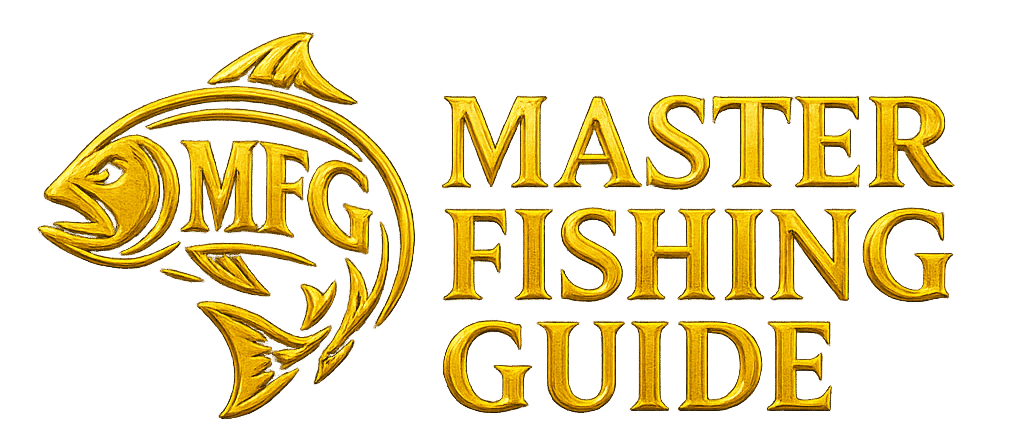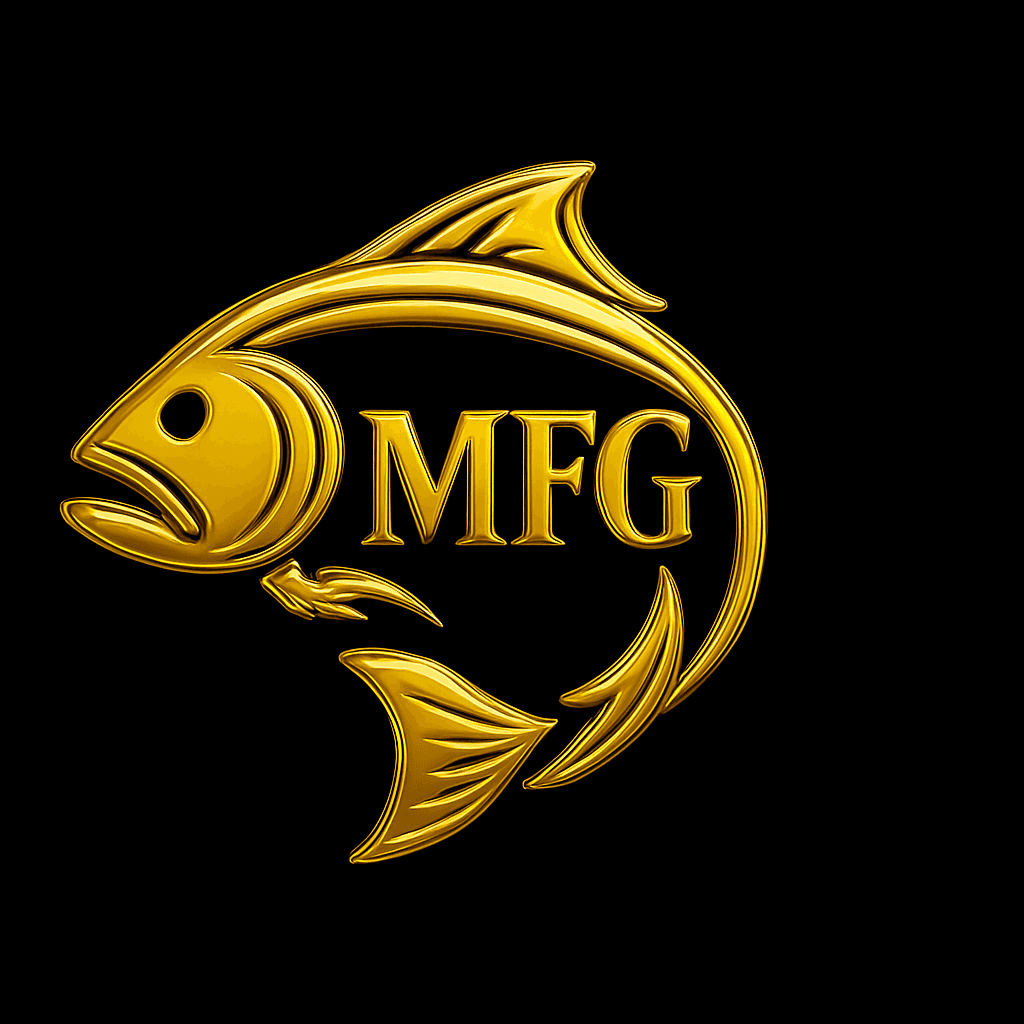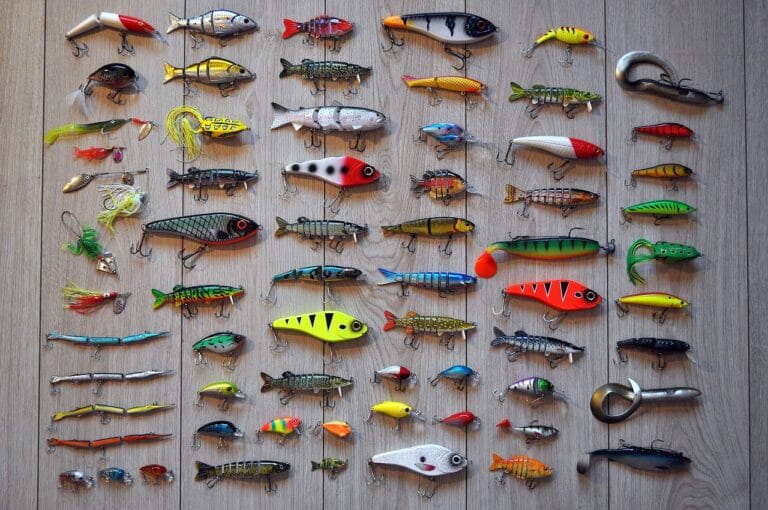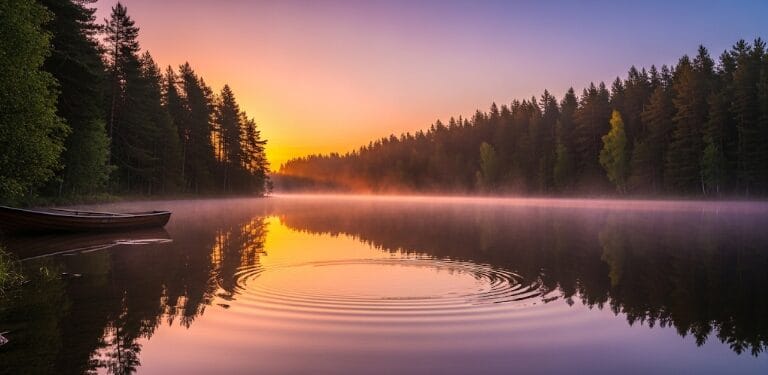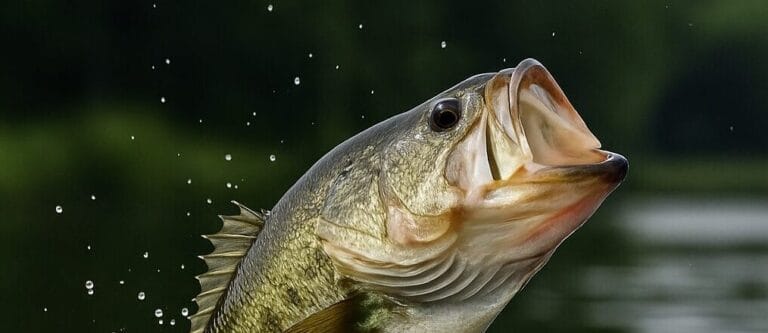Cold Water Bass Fishing (Late Fall & Winter Guide 2025)
We’ve spent years studying how bass behave in cold water — testing lures on frozen lakes, running sonar scans, and comparing notes from anglers across the world. After countless hours both on the water and online, one truth became clear: winter bass fishing is a different game entirely. It’s slower, more tactical, and demands precision. Through this guide, we’ll share exactly what we’ve learned — which lures work, under what conditions, and how to trigger bites when the water feels like ice.
When temperatures drop below 60 °F (15.6 °C), most anglers pack up their rods, unaware that this is the moment when the biggest bass of the season start to feed. Cold-water fishing isn’t about luck or aggression; it’s about patience and control. The thrill of landing a 7-pound largemouth in 45 °F (7 °C) water isn’t for everyone — but for those who adapt, it’s one of the purest tests of skill an angler can face.

As an Amazon Associate, we earn from qualifying purchases — no cost to you. That’s how we keep this site running. Read more ›
As late fall turns into winter, bass become methodical. Their metabolism slows, they move deeper, and every cast has to count. This guide breaks down the science, strategy, and setup that help serious anglers catch fish when others stay home. If you’ve already mastered warm-water techniques, it’s time to learn how to dominate the cold — and discover why winter can quietly deliver your biggest bass of the year.
Before diving in, it’s worth revisiting our Best Bass Fishing Guide 2025, which explains the core patterns and lure logic that make this cold-water approach even more effective.
How to Fish for Bass Below 50 °F (10 °C): Cold-Water Strategies
Once the water temperature dips below 50 °F (10 °C), bass behave differently — they stop chasing fast-moving baits and settle into a more energy-efficient rhythm. This is when precision and timing become more important than speed. Successful cold-water anglers know that every presentation must look like an easy meal, not a chase.
Start by identifying stable temperature zones — deep points, rocky ledges, and mid-lake humps that hold slightly warmer water. Use your electronics to find baitfish schools, and position your lure just above them. Bass in this temperature range often suspend and strike upward, so keeping your bait a few feet above their depth is key.
Another proven strategy is adjusting your retrieve speed and cadence. Long pauses with jerkbaits, slow lifts with blade baits, or dragging a finesse jig along the bottom will consistently outproduce fast-moving lures. In cold water, it’s not about how often you cast — it’s about how long you keep your bait in the strike zone.
As the temperature continues to fall toward 45 °F (7 °C), consider switching to smaller profiles and lighter lines. Bass become less willing to move far for food, so downsizing your presentation keeps bites coming even in the toughest conditions.
Where Do Bass Go in Winter? Points, Ledges, and Creek Channels Explained
When water temperatures fall below 50 °F (10 °C), bass begin to move toward their wintering areas — deeper, more stable zones where the temperature and oxygen levels stay consistent. These are usually main-lake points, rocky ledges, and creek channels that provide easy access to both deep and shallow water. The fish don’t vanish — they just relocate to where survival is easier.
During early winter, you’ll often find bass holding near secondary points or channel swings — areas where creeks bend close to the main river or lake channel. These are prime ambush spots because baitfish schools are forced to travel through narrow corridors. Once bass settle into these zones, they usually stay there until the temperature climbs back above 55 °F (12.8 °C).
On reservoirs and large lakes, look for submerged structure like rock piles, timber lines, or shell beds sitting between 15–30 feet (4.5–9 meters). These spots act as both cover and temperature buffers. Bass prefer to suspend just off these structures, waiting for easy targets to pass by.
In smaller lakes and ponds, the same principle applies but on a smaller scale. Target the deepest basin available, especially if it’s near a drop-off or steep bank. Even a few degrees warmer water can make a big difference when the surface temperature hovers around 40–45 °F (4–7 °C). One classic example is a bass lake with sharp depth transitions and mid-lake structure — that’s where winter fish tend to stack up until spring returns.
Best Cold-Water Lure Arsenal (2025 Edition)

After months of testing across frozen lakes, slow rivers, and muddy reservoirs, these ten cold-water lures proved to catch bass when the water temperature drops below 55 °F (12.8 °C). Each bait on this list has been field-tested by MFG and trusted by experienced winter anglers.
1. Megabass Vision 110 (Jerkbait)
The gold standard for cold-water jerkbaits. Long pauses and subtle twitches make it deadly in 48–55 °F (9–12.8 °C) water when bass suspend and hesitate to chase. Best winter colors: Ghost Shad, GP Pro Blue, Matte Pearl White.
2. Rapala Shadow Rap Deep
A slow-suspending jerkbait designed for deep, cold fish. Perfect below 50 °F (10 °C) when bass need more flash and hang time to commit. Best winter colors: Silver, Ghost, Blue Back Herring.
3. Lucky Craft Pointer 100SP
Legendary Japanese jerkbait with neutral buoyancy and tight action — one of the most consistent producers in clear, cold water between 45–52 °F (7–11 °C). Best winter colors: Aurora Black, Ghost Minnow.
4. Strike King Red Eye Shad (Lipless Crankbait)
A proven cold-water favorite. Tight wobble, loud rattle, and slow fall trigger reaction bites from lethargic fish hiding in grass or deep structure. Best winter colors: Delta Red, Chrome Sexy Shad, Chrome Blue.
5. Yo-Zuri Rattl’n Vibe
Hard-vibrating lipless crankbait that excels in stained or cold, flat water. Great for covering large areas and waking up inactive bass. Best winter colors: Blue Chrome, Black Silver.
6. Strike King Tour Grade Football Finesse Jig
Compact finesse football jig that dominates on rocky bottoms at 40–50 °F (4–10 °C). Fish it slow and steady — subtle is deadly in winter. Best winter colors: Green Pumpkin, Brown Purple, Black/Blue.
Strike King Tour Grade Football Finesse Jig
7. Z-Man ShroomZ™ Micro Finesse Jig
Ultra-compact micro jig designed for light line and pressured winter bass. Perfect for cold, clear lakes where subtle movement makes the difference. Best winter colors: Green Pumpkin, Black/Blue.
Z-Man ShroomZ™ Micro Finesse Jig
8. Acme Hyper-Rattle (Jigging Lure)
Cold-water vertical killer with a built-in rattle chamber and tight, lifelike swim — ideal for 38–48 °F (3–9 °C) when bass key on dying baitfish. Best winter colors: Purple Rain, Green Tiger, Glow Perch.
9. Keitech Easy Shiner 3″
Soft swimbait that swims naturally even in icy water. Excellent for slow rolling near bottom or on a light jig head. Best winter colors: Sight Flash, Blue Gill Flash, Electric Shad.
10. Strike King Rage Swimmer
Compact paddle-tail swimbait with a tight, subtle kick. Perfect for 42–50 °F (5–10 °C) water when bass feed slow but steady. Best winter colors: Ghost Shad, Green Pumpkin Pearl, Tennessee Shad.
How to Retrieve Lures for Winter Bass (Cold Water Techniques 2025)
Once water temperatures fall below 55 °F (12.8 °C), speed kills. Every successful cold-water retrieve is built on one rule — slow down more than you think you should. Bass metabolism drops drastically in winter, and they simply don’t chase fast-moving baits. If you’ve ever wondered how to catch bass in 45-degree water, the answer starts here — slow retrieves, long pauses, and precision.
1. The Slow Jerkbait Pause Method
Anglers often ask how to fish jerkbaits in cold water, and the truth is simpler than most think: you have to slow everything down. Instead of working your jerkbait with fast, twitchy movements like in spring, switch to a slower cadence. Two gentle twitches followed by a long 5–10 second pause often trigger more bites than constant action. On extremely cold days (below 45 °F / 7 °C), extend your pause to 15 seconds or more. Bass often strike when the lure is completely still. Try proven jerkbaits like the Megabass Vision 110 or the Rapala Shadow Rap Deep for the most consistent results.
2. Drag, Don’t Hop, Your Jigs
In cold water, bass hold tight to the bottom. Lifting and hopping your jig wastes energy and looks unnatural. Drag it slowly across rocks, gravel, or points, feeling every bump. This slow retrieve vs stop-and-go winter fishing approach keeps your jig in the strike zone longer and matches the slower movements of real forage. Most strikes will feel like extra weight rather than a hard hit — so set the hook gently and steady. Compact models like the Strike King Tour Grade Football Finesse Jig or the Z-Man ShroomZ™ Micro Finesse Jig excel in this style of fishing.
3. Tight-Wobble Crankbaits for Subtle Vibration
When water temperatures drop under 50 °F (10 °C), crankbaits with a tight wobble outperform wide-action models. The best way to retrieve lures for winter bass is to maintain a consistent, slow vibration that mimics shad trying to survive the cold. Use flat-sided or lipless cranks like the Strike King Red Eye Shad or the Yo-Zuri Rattl’n Vibe, and retrieve them just fast enough to feel the vibration. If you bump bottom or cover, pause briefly — that’s when most bites happen.
4. Vertical Blade Bait Lifts
Blade baits like the Acme Hyper-Rattle are deadly when bass suspend near drop-offs. Drop the lure straight down, lift it about a foot, then let it flutter back down. That subtle flash imitates dying baitfish perfectly. In 42–48 °F (5–9 °C) water, this technique can outfish every other lure in your box — especially when bass refuse to chase horizontal baits.
5. Swimbaits and the “Crawl” Retrieve
Soft swimbaits such as the Keitech Easy Shiner or the Strike King Rage Swimmer should be fished at a crawl — literally as slow as you can turn the reel handle while keeping the tail moving. Keep the bait close to the bottom or slow-roll it along rocky ledges. This technique is crucial when trying to catch bass in 45-degree water where slow movement mimics a struggling baitfish. The key is consistency, not speed.
6. Match Retrieve to Water Clarity
In clear winter water, subtle movement and long pauses work best. In muddy or stained water, add vibration and slightly faster retrieves so bass can locate the lure. Always start slow, then adjust upward — never the other way around. Cold-water fishing is a mental game, and the angler who adapts his retrieve rhythm wins every time.
Cold-water bass fishing rewards patience. When others stop casting, slow down, watch your line, and stay ready — the bite will come when you least expect it. Mastering these retrieves will teach you how to fish jerkbaits in cold water, control your cadence, and finally understand why the slow retrieve always wins in winter.
Where to Find Bass in Cold Water (Depth & Structure Guide 2025)

One of the most common questions every angler asks during late fall is where do bass go in winter. When the water cools below 50 °F (10 °C), bass change location, depth, and feeding zones completely. They don’t vanish — they simply move to areas where energy is conserved, baitfish are concentrated, and temperatures are stable.
How Deep Are Bass in Cold Water?
Depth depends on the body of water and clarity. In clear reservoirs, largemouth bass often settle between 15 and 30 feet (4.5–9 m). In murky lakes, they stay shallower, typically 8–15 feet (2.5–4.5 m). Smallmouth and spotted bass may hold deeper, following structure down to 40 feet (12 m) if the forage is there. The rule is simple: the clearer the water, the deeper they go.
Key Winter Bass Locations
Look for deep water access near shallow feeding areas. The best winter bass fishing locations always include quick depth changes — creek channels, ledges, and rocky points close to deep water. Bass move vertically during temperature swings, rising to feed on warmer afternoons and sliding back down after sunset.
Best Structure for Winter Bass
In winter, bass position tight to structure for stability and warmth. Focus on:
- Rock transitions — areas where chunk rock meets gravel hold heat and crawfish.
- Bridge pilings and docks — absorb sunlight and create shade contrast.
- Submerged timber — offers ambush cover and warmth from trapped gases.
- Channel bends — natural gathering zones for both baitfish and predators.
Temperature and Sunlight Patterns
Even a 2–3 °F (1 °C) increase can pull bass shallower. On sunny days, check north-facing banks that receive maximum light. Rocks, riprap, and clay banks absorb and radiate warmth faster than sand or mud. If the air temperature hits 50 °F (10 °C) with sunlight, expect activity to spike in the upper 10 feet (3 m) of the water column.
Follow the Bait, Not the Calendar
In cold water, bass follow the food. Use your electronics to locate shad or perch schools, then fish just beneath or beside them. If you spot bait suspended at 20 feet (6 m), that’s your strike zone. When the bait moves deeper than 30 feet (9 m), switch to vertical presentations like a Johnson ThinFisher or jigging spoon.
Knowing how deep bass are in cold water is the foundation of successful winter fishing. Combine slow retrieve techniques with smart location choices — and you’ll stay on fish while others are waiting for spring to arrive.
Best Time of Day to Catch Winter Bass (Temperature & Weather Guide 2025)
Ask any experienced angler and you’ll hear the same thing — timing is everything. Knowing the best time to fish for bass in winter isn’t guesswork, it’s a science based on water temperature, sunlight, and feeding cycles. Bass behavior changes drastically with every few degrees of temperature shift, especially below 55 °F (12.8 °C).
What Temperature Do Bass Bite in Winter?
Bass will bite in surprisingly cold conditions, but their strike zone narrows as the water cools. The most active window is usually between 45 °F and 52 °F (7–11 °C). Below 42 °F (5.5 °C), bites slow down dramatically, and only the most precise presentations work. Once the temperature drops under 40 °F (4.4 °C), the metabolism is so slow that bass feed just once or twice a day.
Morning vs Afternoon Bass Fishing
In summer, mornings are prime time — but in winter, afternoons win. The best time to catch winter bass is typically between 11 a.m. and 3 p.m. when sunlight has had time to warm the upper layer of the water. South-facing banks, riprap, and rocky points absorb heat and create microclimates where bass become more active.
Cold Fronts and Pressure Shifts
After a strong cold front, bass often bury deep and become inactive for 24–48 hours. Wait until high pressure stabilizes, then target slow, sunny afternoons with minimal wind. A warming trend of even 2–3 °F (1 °C) can trigger feeding windows lasting just 20–30 minutes — be ready to capitalize when it happens.
Wind, Clouds, and Light Conditions
During cloudy days, bass tend to move slightly shallower, especially when wind pushes baitfish into coves or along wind-blown points. In clear, calm weather, they retreat to deeper structure. Use bright colors like chartreuse or chrome under clouds, and switch to natural ghost tones in sunshine. Understanding light and wind direction can double your winter success rate.
Night Fishing in Winter — Rare but Rewarding
Most anglers give up after dark, but under stable conditions, winter night bass fishing can produce giants. Focus on rocky points, dam faces, and areas with residual warmth from daylight. Slow-moving jigs and suspending jerkbaits work best. Water around 48–50 °F (8–10 °C) is ideal for a subtle night bite.
Quick Temperature Reference Chart
- 60–55 °F (15–12.8 °C): Fall transition, active bite in shallow water.
- 54–48 °F (12–9 °C): Prime cold-water jerkbait and jig season.
- 47–42 °F (8–5.5 °C): Slow retrieve, deep structure, fewer bites but bigger fish.
- Below 40 °F (4 °C): Fish deep and slow — one or two bites all day, but usually from giants.
Understanding the bass bite chart for winter helps you plan each trip with precision. Focus your effort on warm afternoons after two or three stable days of weather. That’s when even the laziest bass decide to feed — and that’s when true cold-water giants are caught.
Best Cold Water Baits by Temperature (Lure Selection Chart 2025)
Cold-water bass fishing success often comes down to matching lure action to water temperature. Choosing the right bait for each temperature range can turn slow days into career days. This chart breaks down what works best as the mercury drops — based on reliable data and field reports across the U.S., Canada, and Japan.
55–50 °F (12.8–10 °C): Transition Zone
During the early cold season, bass are still active enough to chase. Use medium-diving crankbaits, spinnerbaits, and swimbaits with moderate speed. Colors like shad, chrome, and chartreuse work well in stained water. You can verify seasonal water behavior on NOAA’s Climate Data Center to match temperatures with feeding trends.
49–45 °F (9.4–7 °C): Prime Jerkbait Season
This is when suspending jerkbaits dominate. Go with models like the Megabass Vision 110 or Rapala Shadow Rap Deep. Long pauses and natural colors like Ghost Minnow or Matte Pearl Shad produce best results. Regional cold fronts and water temperature charts from USGS can help you track bite timing more accurately.
44–40 °F (6.6–4.4 °C): Blade Bait and Jig Time
Here, water gets cold enough that bass demand a near-dead retrieve. Blade baits like the Acme Hyper-Rattle or Silver Buddy mimic dying baitfish perfectly. Crawl a Strike King Tour Grade Football Finesse Jig with a small trailer across rocks and gravel — that’s where winter crawfish hide. Check Take Me Fishing for general seasonal fishing techniques and lure movement tips.
Below 40 °F (4.4 °C and under): Finesse and Vertical Only
When the water hits its coldest, bass often stop chasing horizontal baits. That’s when vertical finesse and subtle presentations win. Drop-shot rigs, compact blade baits like the Acme Hyper-Rattle, or ice spoons above marked fish work best. Natural colors — silver, smoke, or clear tones — always outperform bright shades in near-freezing clarity. Data from USGS Water Data confirms that even a 1–2 °F change can trigger vertical movement.
Color Selection for Winter
Winter light is weak and water clarity changes daily. As a rule of thumb:
- Clear water: translucent shad, ghost minnow, or pro blue.
- Stained water: chartreuse, fire tiger, and gold flash.
- Muddy water: black/red combos for maximum contrast.
Stick to subtle flash and tight vibration — that’s the language bass understand in near-freezing water.
Cold-water bass fishing isn’t about how many casts you make — it’s about making the right ones. Match your bait, color, and retrieve to the exact temperature, and you’ll outfish anyone on the lake this winter. When you finally land that giant in freezing water, share your catch on the Master Fishing Guide Facebook Page — we’d love to see your cold-water success story.
